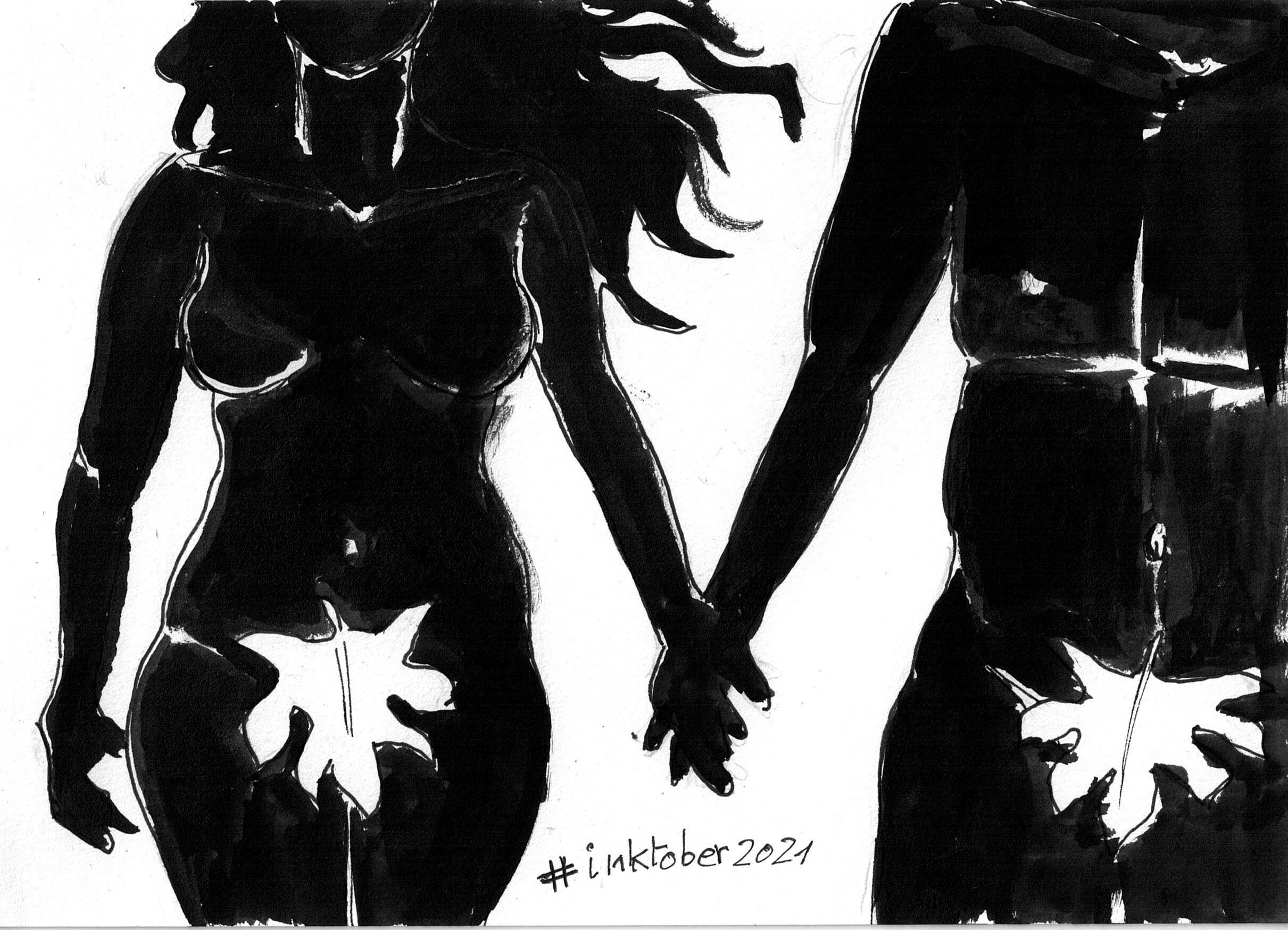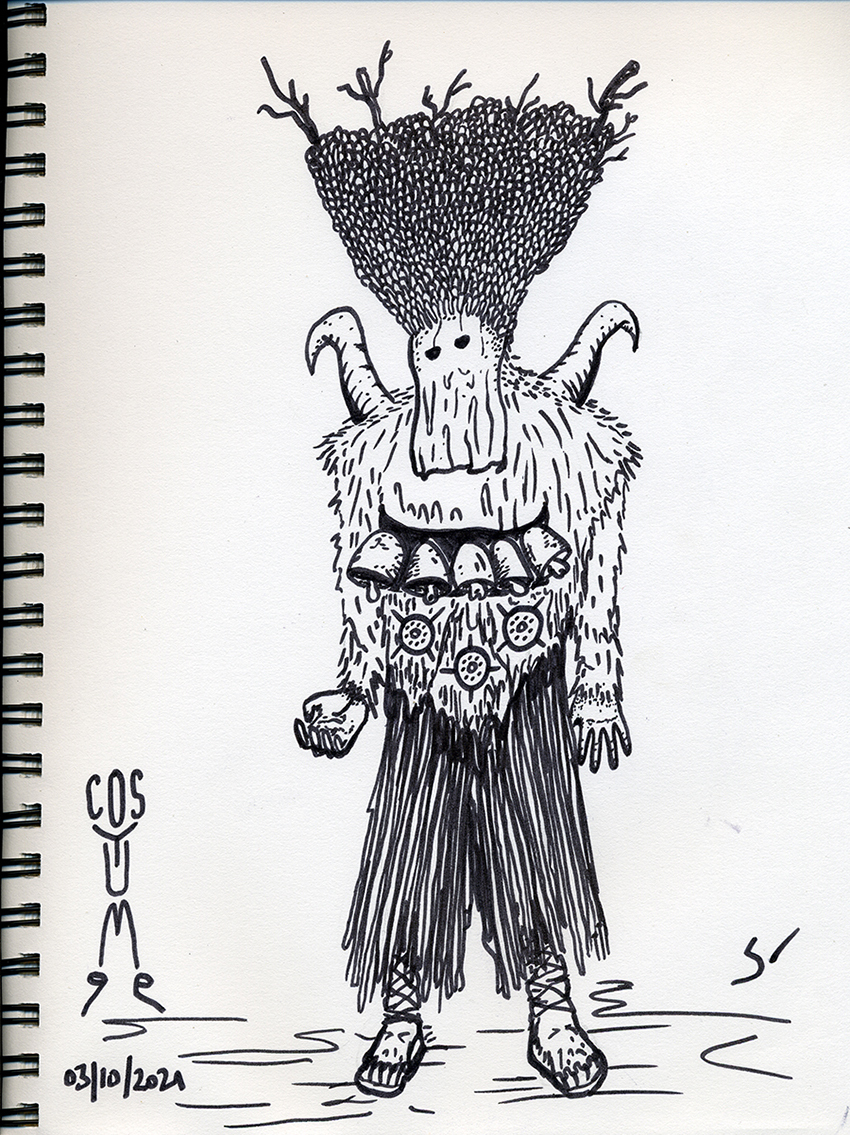#costume
Des costumes dans le ciel
- Dis, je pense à un truc : tu te souviens de Delphine et Marinette ?
- Euh... Celles du chat et de la culotte de gendarme ?
- Oui, exactement. Je crois que nous devrions nous en inspirer.
- Pourquoi ? Le monde des humains est déjà totalement envahi par des chats. Et on voit bien le sort réservé à ces jeunes filles et à leurs congénères...
- Je pensais plutôt à la culotte de gendarme. Il faudrait imaginer des costumes dans le ciel afin que, par temps d'éclaircie, les hommes puissent en découper quelques-uns.
- Quelle drôle d'idée !
- Cela les motiverait peut-être à lever les yeux pour se repérer et trouver de nouveaux horizons.
- Ah ouais... Dis-donc, tu es en forme olympique en ce moment ! C'est quoi la recette de ton smoothie d'ambroisie ?

Les amants
#inktober2021 #inktober #jour2 #suit #costume #amants #amour #couple #feuilledevigne #dessin #gribouillage #drawing #art #amateur #mywork #d3 #enjomineur
L'amour peut nous mettre à nu, même s'il n'est reste pas moins vrai, qu'on n'a pas besoin de porter un costume, pour endosser un rôle.
Demain, le thème est "vaisseau/navire". Je sens déjà le naufrage.

« Bruit suspect » : reprise du trait et des détails à la mine 2B. :)
#art #illustration #bellaminette #costume #Tipeee
Vous aimez ?
Aidez : https://fr.tipeee.com/bruno-bellamy

#croquis en #bleu (première ébauche) : encore une #bellaminette en #costume… Cette fois, c’est un #cosplay de #soubrette ;)
#art #illustration #sketch #sexy #Tipeee
vous aimez ?
Aidez : https://fr.tipeee.com/bruno-bellamy !

#croquis en #bleu : ébauche et recherche sur une #bellaminette en #costume, pour changer (j’ai pas encore trouvé de titre, mais on dirait qu’elle est intriguée par un bruit suspect, non ?). :)
Vous aimez ?
Aidez, sur #Tipeee : https://fr.tipeee.com/bruno-bellamy !

« Et si… ? », ainsi que la 2e #bellaminette du mois (qui restera secrète jusqu’au déballage dans la prochaine vidéo, ça sera la surprise) viennent de partir à l’impression. Ce seront les DEUX ex-libris pour les tipeuses et tipeurs de mai, grâces leur soient 1000 fois rendues :)
#art #illustration #costume #sexy #bijoux #Tipeee

« Et si… ? » : finitions à l’encre dorée… :)
Ça fait joli au soleil, en plus !
#art #illustration #bellaminette #costume #bijoux #Tipeee
Vous aimez ?
Aidez : https://fr.tipeee.com/bruno-bellamy :)

« Et si… ? » : j’ai terminé les aplats de couleur, il me reste à faire les petits détails, repasser les trais au pinceau, etc… :)
#WIP #aquarelle #bellaminette #costume #sexy #Tipeee
Il vous reste jusqu’à ce soir seulement pour en profiter : https://fr.tipeee.com/bruno-bellamy

« Et si… ? » : #aquarelle en cours… :)
C’est la #bellaminette du mois, pour les gens qui me soutiennent sur #Tipeee
Profitez-en, vous aussi, surtout que ce mois-ci, le seuil « double ex-libris » est franchi : https://fr.tipeee.com/bruno-bellamy
#art #illustration #costume #sexy

« Et si… ? » : #aquarelle commencée !
Et oui, elle aura la peau chocolat. :)
C’est la #bellaminette du mois pour les tipeuses et tipeurs de mai… pour en profiter, c’est ici : https://fr.tipeee.com/bruno-bellamy ;)
#art #illustration #costume #sexy #Tipeee

#WIP « Et si… ? » : report du trait à la mine 2B sur papier #aquarelle, à la table lumineuse.
#art #illustration #bellaminette #costume #sexy #Tipeee
Vous aimez ?
Aidez : https://fr.tipeee.com/bruno-bellamy

« Et si… ? » : scan du crayonné !
Ce sera la #bellaminette du mois, et donc l’ex-libris (plus un autre -encore secret- puisqu’il y en a deux ce mois-ci) pour les tipeuses et peurs de mai !
Si vous aimez, aidez, et profitez-en : https://fr.tipeee.com/bruno-bellamy
#art #illustration #sexy #costume #Tipeee

« Et si… ? » : crayonné abouti.
Ce sera la #bellaminette du mois (qu’il me reste donc à refaire à l’#aquarelle) pour les tipeuses et tipeurs de mai, et en plus le seuil « double ex-libris » est franchi, ce qui veut dire que les gens qui me soutiennent ce mois-ci, en plus de la repro qui sera tirée de ce dessin, en recevront une DEUXIÈME, qui sera une surprise (révélée dans la prochaine vidéo) !
#art #illustration #costume #Tipeee
Vous aimez ?
Aidez : https://fr.tipeee.com/bruno-bellamy

« Et si… ? » : ébauche en bleu, 2e étape (version un peu plus avancée du crayonné de cette #bellaminette en #costume et en état de grande perplexité) ;)
#art #illustration #sexy #sketch #croquis #Tipeee
Vous aimez ?
Aidez : https://fr.tipeee.com/bruno-bellamy







